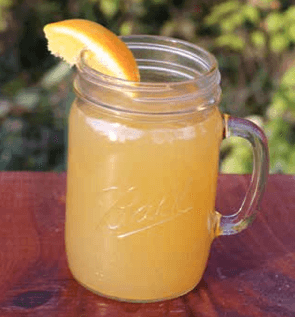To Hop or Not to Hop?

For you IPA-loving readers, you may be asking yourself if there is any legitimacy to our query: The answer, of course, is TO HOP. But what if we told you there is another way? It’s okay, you can keep drinking your IPA while you read this but by the end, you may be rethinking everything you’ve come to believe about hops!
The following excerpt and recipes are from Brew Beer Like a Yeti by Jereme Zimmerman and have been adapted for the web.
Hops
Hops are what makes beer beer, right? By now you should know that this isn’t entirely true, but many who haven’t studied beer history or brewing are surprised to learn that beer and ale don’t necessarily need to contain hops. Those who suggest that perhaps an overabundance of hops in beer isn’t always a good thing—particularly when talking to aficionados of American craft beer—are often met with confusion or even vociferous disagreement. When my IPA-loving friends learn of my desire to make beer with little to no hops, they tend to hold tightly to their IPAs and look at me with great concern.
 However, I’ve found that there are plenty of people out there who are not hop lovers—or who are more interested in the idea of historical beer made with herbs and other traditional bittering and flavoring agents. I enjoy the flavor of hops in beer, and appreciate the bittering they provide to counteract the sweetness of malt. However, I’m also a fan of the underdog—all those other herbs that haven’t been given their due—and of re-creating history in a bottle.
However, I’ve found that there are plenty of people out there who are not hop lovers—or who are more interested in the idea of historical beer made with herbs and other traditional bittering and flavoring agents. I enjoy the flavor of hops in beer, and appreciate the bittering they provide to counteract the sweetness of malt. However, I’m also a fan of the underdog—all those other herbs that haven’t been given their due—and of re-creating history in a bottle.
The intent of this book is not to be “anti-hops” but rather to step back and learn to use hops for balance and nuance—or primarily for their antibacterial properties—rather than focusing on “hop-forward” beers. And of course, you can forgo hops altogether and use other ingredients for their bittering, flavoring, and preservative properties.
There are more than 200 hop varieties—both wild and domestic—with more being developed and tested in beer all the time. Of these, around 30 to 40 have become brewing standards and thus are readily accessible to commercial and homebrewers, while others have lost their popularity and been cast aside. Beer flavors are dizzyingly diverse due not only to the nuances of each variety, but also variations in timing when they’re added to the wort during the brewing and fermentation processes.
Some hops are subtle and mid- to low alpha, some are high-alpha and bitter, some are citrusy and aromatic and ride high on the “nose” when you sip, some are well balanced and “noble” (noble is a classification of traditional European hops known for their low alpha acids, soft well-rounded flavor, and subtle aromatic qualities), and some just march to the beat of their own drummer. Although many herbal additions and adjuncts such as honey provide their own antibacterial properties, hops can also be used in small amounts to ensure that a beer such as a long-aged Belgian will keep over time (though, again, there are many factors and ingredients other than hops that will ensure a “clean” aging). One technique Belgian and other European brewers have taken to is using stale hops early in the boil. This imparts little to no bittering or aroma, but still has the antibacterial properties necessary for long-term aging.
In modern brewing, particularly modern American craft beer, hop varieties play a huge role in the overall character of the beer. In traditional European brewing hops tend to be more of a supporting player and—as we’ve seen—didn’t necessarily play a role at all historically. The recipes in this book, based primarily on early European and colonial American brewing, consider the characters of malt, adjuncts, and herbs and spices in determining the flavor of a beer rather than those of hops.
For most beers, I recommend low-alpha varieties unless you want a high level of bitterness. I will also look for low-alpha-range varieties (Germany’s Spalter and Tettnanger are good ones) if I want to use hops primarily for their preservative effect. Hops aren’t actually bitter until they’ve been boiled, so if you do like a bit of a hoppy aroma, you can always adjust any of these recipes by adding 1⁄2 ounce (15 g) of low-to- mid-alpha hops during the last two minutes of the boil, or after cutting off heat. If I’m looking for hops that provide just a hint of bitterness and aroma, I look for mid-alpha-range varieties (British varieties such as Kent Golding and Fuggle are some of my favorites).
So what does this all mean for the brewer who just isn’t all that interested in hops or, like me, is more interested in experimenting with other flavoring and preservative ingredients and doesn’t feel the need to get all geeky-techie? First off, if you want to experiment with brewing without hops, but don’t want to give up on them altogether, it is of paramount importance to know what effect any addition of hops will have on the final product.
Second, although we’re talking primarily about the effect of adding hops to the boil, there are some similarities in the timing of additions of herbs, spices, and other ingredients. Botanical ingredients with any degree of bittering impart a much greater degree of bitterness if added early in the boil.
On the flip side, whether an ingredient has a noticeable bittering effect or not, its flavor and aroma will usually be lost or barely noticeable if added anytime before the last 5 to 10 minutes of the boil. Preservative/antibacterial effects will be present no matter when you add them. The bulk of modern research on this subject has been done on hops, although we know a fair degree about the effects of other ingredients. With the vast array of potential ingredients you can add to a brew, it would be a daunting task to outline all of their effects to the degree that has been done with hops. However, many have similar qualities that help us estimate the effect each will have.
I’ll admit, I still find it difficult to completely forgo hopping my homebrews. Maybe it’s that hops were a big part of the magic when I made my first brew many years ago. Adding hops has its own schedule, its own set of specific instructions and warnings that if not done just right . . . well, the beer might taste a bit different than it was supposed to. Though over the years, I’ve come to find that there are many other ingredients that can lend their own mystique to a brew, sometimes I want a hint of hoppiness to balance out another flavor, such as when I make a spruce beer, as spruce and hops complement each other well.
Other times I may want to use hops strictly for their strong antiseptic properties. To put it simply, if I want to use hops, ain’t nobody stopping me, but if I’d rather not, well, ain’t nobody stopping me from that, either. Mostly, though, I hope more people come to understand that hops are by no means required for beer and, even when they are used, can be considered for balance and nuance rather than the dominant flavor.
Spruce Simple Ale
Spruce was a common flavoring and preservative ingredient used along with or instead of hops, and often brewed with molasses. I provide grain-based recipes for spruce beer later on in this chapter, but for now, here is a simple ale version. As with any simple ales, you can use molasses, brown sugar, cane sugar, honey, or any combination. Most traditional recipes call only for molasses, but I find molasses to be a bit much when used exclusively, so I usually go with brown sugar or half brown sugar/half molasses.
Ingredients for 1 gallon (4 L)
1 gallon (4 L) spring water or filtered tap water
1⁄2 pound (0.25 kg) cane sugar
1⁄2 pound (0.25 kg) molasses
1⁄2 ounce (14 g) low-alpha hops (optional)
2–4 spruce tips (more or less depending on the intensity of their smell/flavor)
1⁄2 teaspoon brewing yeast, ale yeast, or bread yeast, or 1⁄2 cup (125 mL) barm
Process
- Bring the water just to a boil in a stockpot.
- Stir in the sugar and molasses until fully dissolved.
- Add the hops (optional).
- Heat at a low, rolling boil, shut off the heat after half an hour, and add the spruce.
- Let the wort cool, strain into a fermenter, add the yeast, ferment for about 2 weeks, prime, bottle, and begin sampling in about a week.
Pawpaw Wheat/Simple Ale
If you’re not familiar with the pawpaw (Asimina triloba), I highly recommend the book Pawpaw: In Search of America’s Forgotten Fruit by Andrew Moore. It’s a well-informed and engaging love song to this all-American fruit as well as a travelogue through the regions of North America where the pawpaw is prevalent. Although sometimes found in outlying areas, it tends to grow as far south as Louisiana and Alabama, as far north as Michigan and Illinois, as far west as Kansas, and it spreads nearly to the Atlantic on the East Coast. “Pawpaws are a river fruit,” says Moore. “They grow under many conditions and in many climates, but they’re most abundant and reliably found growing in the deep alluvial soli of American bottomlands, along creeks, streams, and great rivers from the mighty Mississippi to the Wabash, Susquehanna, Missouri, and Potomac.” I’m lucky enough to live in a region (eastern Kentucky) where they are prevalent.
 Ingredients for 1 gallon (4 L)
Ingredients for 1 gallon (4 L)
2 pounds (1 kg) pawpaws, mangoes, bananas, or persimmons
1 gallon (4 L) spring water or filtered tap water
1 pound (0.5 kg) wheat DME (or substitute cane sugar for a simple ale)
1⁄2 ounce (15 g) low-alpha hops such as Willamette or Fuggle (optional)
1⁄2 ounce (15 g) fresh or 1⁄4 ounce (7 g) dried mugwort or yarrow leaves (optional)
1⁄2 teaspoon crushed coriander
Juice of 1⁄2 small lemon, or 2 ounces (60 mL) lemon juice
Wheat, Belgian or bread yeast, or barm
Process
(Skip to step 5 if using malted corn)
- Peel and deseed (if you’re using pawpaws or mangoes) the fruit and set aside.
- Bring the water to a barely rolling boil and stir in the extract or sugar.
- Add the optional bittering herbs and boil for half an hour.
- Cut off the heat and add the coriander, lemon juice, and fruit.
- Let the mixture cool, then transfer everything, fruit and all, to a bucket, crock, or other widemouthed fermenter (this can produce a lot of krausen) and sprinkle the yeast over surface.
- Place the fermenter in a warm area with a cloth over it for 24 hours or until fermentation slows down.
- Filter out the solids and rack to a 1-gallon (4 L) jug with airlock.
- Prime with 1⁄2 cup (100 g) of cane sugar, and bottle.
Recommended Reads
Recent Articles
Indulge in the sweet aroma of these pastry-wrapped pears! Easy to make and stunning to serve, these pastry-wrapped pears are a game-changer.
Read MoreThe scent of fir trees is a holiday staple 🎄 Imagine sipping a festive cocktail infused with the unmistakable taste of fir ✨ This holiday season, elevate your entertaining game by introducing fir to your menu – from classy cocktails to rustic potatoes!
Read MoreDitch boring snacks and upgrade to adorable fruit & veggie treats you’ll love! Brighten up snack time this winter using fruits and veggies we all know and love. Can you resist taking a bite of these cuties?
Read More


 Ingredients for 1 gallon (4 L)
Ingredients for 1 gallon (4 L)







